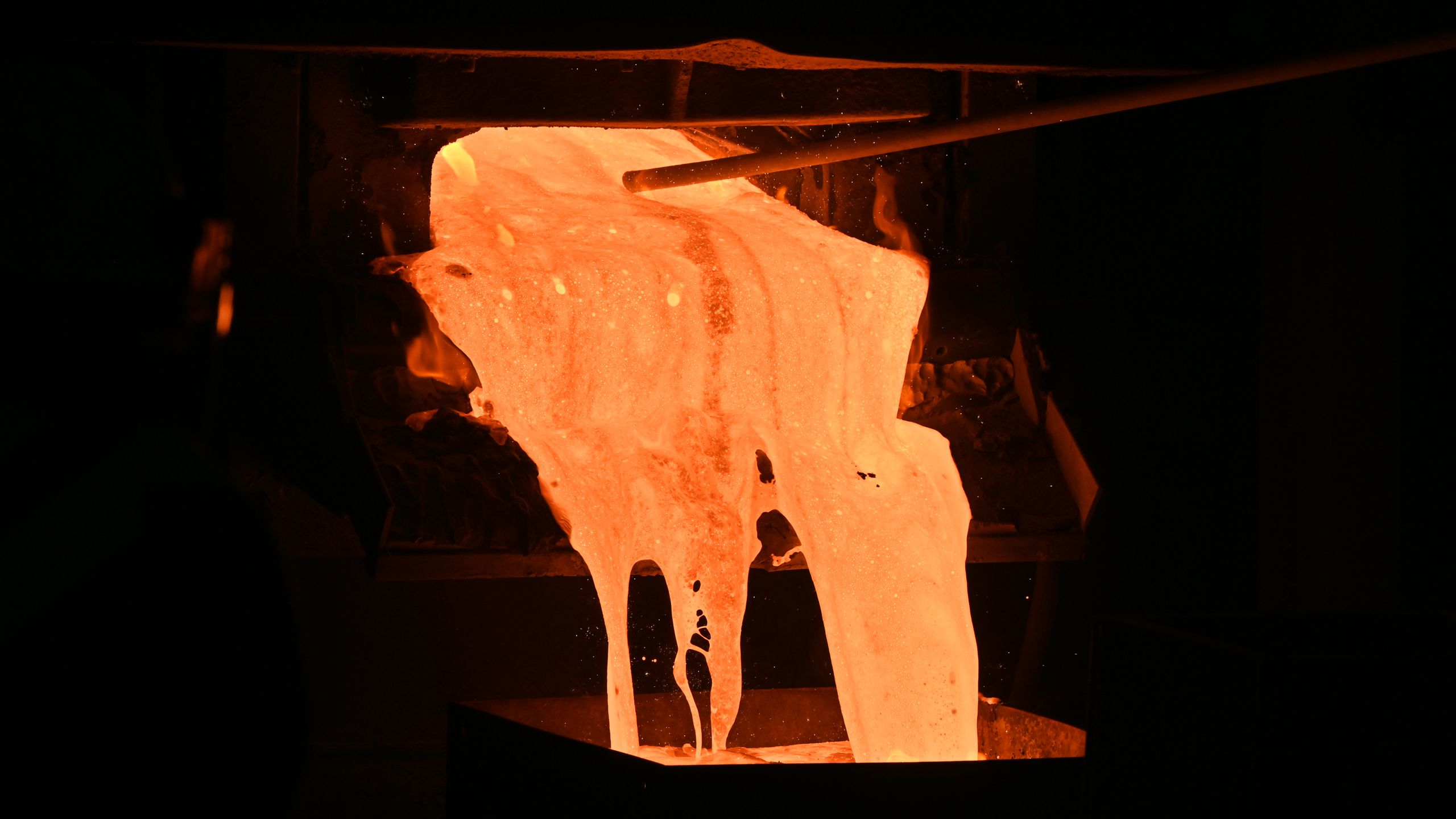Cement 2 Zero
The world’s first potentially zero-emission cement has been trialled at industrial scale with a consortium of leading industry partners

Cement 2 Zero
The world’s first potentially zero-emission cement has been trialled at industrial scale with a consortium of leading industry partners
The breakthrough process co-recycles steel and concrete waste to produce a low-carbon alternative to traditional Portland Cement.
Decarbonising cement is one of the hardest challenges on the journey to zero emissions, but a ground-breaking discovery could hold the solution.
Cambridge Electric Cement (CEC) is the world’s first potentially zero-emission cement. It is made by reactivating old cement from waste concrete in furnaces used for steel recycling. Crucially, the process leverages existing steelmaking infrastructure without interfering with steel production, avoiding the emissions from conventional cement production and accelerating the scale-up. Electric arc furnaces used in steel production have the potential to be powered by renewables, which could decarbonise the entire cement-making process.
With £2.75m funding from the Transforming Foundation Industries (TFI) challenge, the Cement 2 Zero project brought together a consortium of academic and industrial partners to take the innovative CEC process from lab-scale innovation to industrial-scale production.
A replacement for Portland Cement
In 2018, 7.3Mt of CO2 emissions were attributable to the UK concrete and cement sector – a substantial amount of which was generated through the production of Portland Cement. The CEC process currently produces a partial replacement for Portland Cement clinker, with further development anticipated to achieve a direct replacement, enabling the same performance with reduced carbon emissions.
The foundations of the innovation lie in a discovery by University of Cambridge researchers, who found that the chemical composition of used cement is virtually identical to that of the flux used in steel electric arc furnaces (EAF). They developed a process that uses cement powder extracted from concrete demolition waste as a supplement to the flux required in steel recycling.
The high-temperature conditions in a steel EAF proved perfect for reactivating the old cement. As the steel melts, the cement forms a slag, which is then removed and cooled rapidly, before being ground into a powder to make the alternative clinker. In 2022, the spin-out company Cambridge Electric Cement Ltd was created to commercialise the low-carbon cement research.
Industrial scale pilot
Cement 2 Zero investigated the technical and commercial aspects of upscaling CEC. “The consortium brought together the whole supply chain for production, from the base aggregates collecting and processing demolition waste, through to the steel furnaces, cement manufacturers and onto construction companies, so we could test every stage of the process and demonstrate how it would work on an industrial scale,” explains Sam Bell from the Materials Processing Institute, which led the project.
Using an extended supply chain supported by external providers and existing equipment to recover cement from concrete, aggregates company Day Group Ltd supplied the raw materials. The first phase of trial melts was carried out using an 80kg induction furnace to prove the basic concept, followed by a 6-tonne pilot-scale EAF at the Materials Processing Institute. Having effectively trialled, developed and de-risked the process, industrial-scale melts are running at CELSA Steel UK’s 150-tonne EAF in Cardiff, targeting 20-tonnes of the low-carbon cement.
“The trials at CELSA demonstrated that the introduction of cement into the furnace did not adversely affect steel production. In fact, we were surprised to find there are potential benefits for steel production,” explains Patricio Burdiles from Cambridge Electric Cement Ltd. “We were not able to totally replace the lime flux with cement, but even adding a layer of cement paste over existing lime produces a cement with far lower emissions. Further development on cement and concrete separation will improve lime replacement.”

“The Cambridge Electric Cement process currently produces a partial replacement for Portland Cement clinker, with further development anticipated to achieve a direct replacement, enabling the same performance with reduced carbon emissions.”

Construction demonstrator
The project explored ways to refine the process, including more efficient capture of cement from demolition waste and faster cooling of the slag. “Slag is a by-product for steel manufacturers, so there’s no need for them to process it in any way. However, the cement process requires the slag to be cooled very rapidly to get the best cementitious properties, so the Materials Processing Institute designed a system that could be added to existing steel plants to achieve the required cooling,” says Bell. “We plan to build a demo at our facilities in the future.”
The final phase of Cement 2 Zero will convene the consortium’s expertise to deploy CEC in test construction projects. Cement producer Tarmac is advising on and testing the specifications of the cement, as well as concrete mixes. Engineering company Atkins Realis is designing a construction demonstrator that will be built by Balfour Beatty.
A circular economy for construction materials
Cement 2 Zero proved that steel and cement recycling can be combined in a single process, which could potentially be powered by renewable electricity. “Our analysis indicates that, very conservatively, we can achieve around 40% of the carbon emissions of Portland Cement without any further improvements to the process,” says Burdiles. “However, with improved separation of cement from concrete waste, furnaces better suited for the technology, and cooling systems in place, we are on the pathway to 80-90% reductions.”
The UK produces 11m tonnes of steel scrap annually, much of which is exported. If this was to be co-recycled, production could meet 25% of UK cement demand. “Cement 2 Zero demonstrates how industrial collaboration can drive the changes we need to make for a zero-carbon society,” says Burdiles. “CEC provides an opportunity to create a more resilient, circular economy for construction materials in the UK. Not only reducing emissions, but also creating high-value materials from demolition waste, and securing jobs in the cement and steel sectors.”

Construction demonstrator
The project explored ways to refine the process, including more efficient capture of cement from demolition waste and faster cooling of the slag. “Slag is a by-product for steel manufacturers, so there’s no need for them to process it in any way. However, the cement process requires the slag to be cooled very rapidly to get the best cementitious properties, so the Materials Processing Institute designed a system that could be added to existing steel plants to achieve the required cooling,” says Bell. “We plan to build a demo at our facilities in the future.”
The final phase of Cement 2 Zero will convene the consortium’s expertise to deploy CEC in test construction projects. Cement producer Tarmac is advising on and testing the specifications of the cement, as well as concrete mixes. Engineering company Atkins Realis is designing a construction demonstrator that will be built by Balfour Beatty.
A circular economy for construction materials
Cement 2 Zero proved that steel and cement recycling can be combined in a single process, which could potentially be powered by renewable electricity. “Our analysis indicates that, very conservatively, we can achieve around 40% of the carbon emissions of Portland Cement without any further improvements to the process,” says Burdiles. “However, with improved separation of cement from concrete waste, furnaces better suited for the technology, and cooling systems in place, we are on the pathway to 80-90% reductions.”
The UK produces 11m tonnes of steel scrap annually, much of which is exported. If this was to be co-recycled, production could meet 25% of UK cement demand. “Cement 2 Zero demonstrates how industrial collaboration can drive the changes we need to make for a zero-carbon society,” says Burdiles. “CEC provides an opportunity to create a more resilient, circular economy for construction materials in the UK. Not only reducing emissions, but also creating high-value materials from demolition waste, and securing jobs in the cement and steel sectors.”

